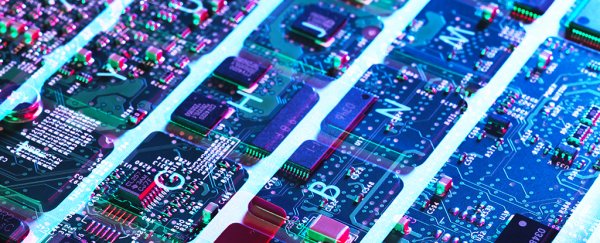As 2019 winds to a close, the journey towards fully realised quantum computing continues: physicists have been able to demonstrate quantum teleportation between two computer chips for the first time.
Put simply, this breakthrough means that information was passed between the chips not by physical electronic connections, but through quantum entanglement – by linking two particles across a gap using the principles of quantum physics.
We don't yet understand everything about quantum entanglement (it's the same phenomenon Albert Einstein famously called "spooky action"), but being able to use it to send information between computer chips is significant, even if so far we're confined to a tightly controlled lab environment.
"We were able to demonstrate a high-quality entanglement link across two chips in the lab, where photons on either chip share a single quantum state," explains quantum physicist Dan Llewellyn from the University of Bristol in the UK.
"Each chip was then fully programmed to perform a range of demonstrations which utilise the entanglement."
Hypothetically, quantum entanglement can work over any distance. Two particles get inextricably linked together, which means looking at one tells us something about the other, wherever it is (in this case, on a separate computer chip).
To achieve their result, the team generated pairs of entangled photons, encoding quantum information in a way that ensured low levels of interference and high levels of accuracy. Up to four qubits – the quantum equivalent of classical computing bits – were linked together.
"The flagship demonstration was a two-chip teleportation experiment, whereby the individual quantum state of a particle is transmitted across the two chips after a quantum measurement is performed," says Llewellyn.
"This measurement utilises the strange behaviour of quantum physics, which simultaneously collapses the entanglement link and transfers the particle state to another particle already on the receiver chip."
The researchers were then able to run experiments in which the fidelity reached 91 percent – as in, almost all the information was accurately transmitted and logged.
Scientists are learning more and more about how quantum entanglement works, but for now it's very hard to control. It's not something you can install inside a laptop: you need a lot of bulky, expensive scientific equipment to get it working.
But the hope is that advances in the lab, such as this one, might one day lead to advances in computing that everyone can take advantage of – super-powerful processing power and a next-level internet with built-in hacking protections.
The low data loss and high stability of the teleportation, as well as the high level of control that the scientists were able to get over their experiments, are all promising signs in terms of follow-up research.
It's also a useful study for efforts to get quantum physics working with the silicon chip (Si-chip) tech used in today's computers, and the complementary metal-oxide-semiconductor (CMOS) techniques used to make those chips.
"In the future, a single Si-chip integration of quantum photonic devices and classical electronic controls will open the door for fully chip-based CMOS-compatible quantum communication and information processing networks," says quantum physicist Jianwei Wang, from Peking University in China.
The research has been published in Nature Physics.
